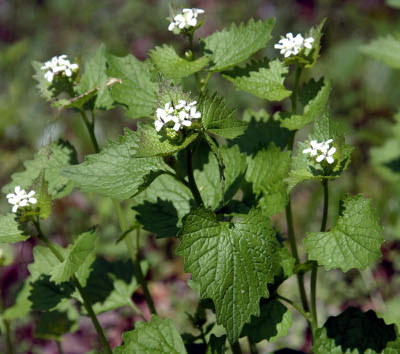Annual invasion of garlic mustard is now underway
Help rid local woodlands of this unwelcome invader by organizing a garlic mustard pull in your neighborhood.

Garlic mustard (Allaria petiolata) has once again started to pop up along the edge in woods and streams. This invasive member of the mustard family spreads rapidly and is unfortunately unpalatable to deer and other wildlife. It has the ability to degrade both pristine woods as well as disturb areas to become the dominant plant on the forest floor. It was introduced from Europe and parts of Asia as a food plant. It chokes out spring ephemerals and other desirable native plants by releasing chemicals into the soil that inhibit the growth of other plant species and mycorrhizae, symbiotic fungi that colonize the roots of trees and help them extract nutrients form the soil.
If you missed Earth Day on April 22, 2014, but still want to do something to improve the woodlands around you, Michigan State University Extension recommends organizing a garlic mustard pull to help get rid of this unwanted invader. You can pull out garlic mustard most easily in spring before the ground starts to dry out. Try to get enough of the root out so that the plant doesn’t have adequate resources to form a new flower stalk. Garlic mustard is a biennial that reproduces by seeds, so you want to make sure that it gets pulled before it can set seed.

Garlic mustard plant. Photo credit: Chris Evans, Illinois Wildlife Action Plan, Bugwood.org
In areas too large to pull by hand, herbicide applications can also be an effective tool to thwart garlic mustard’s spread. Herbicides containing glyphosate (Roundup and others) can be used. If there are desirable plants in the area that you want to avoid spraying, use a wick applicator to wipe the herbicide directly on the garlic mustard without worrying about spray drift, but be aware it will take more time to apply it this way. To be most effective, glyphosate should be applied when plants are actively growing. It will be easiest during the spring when garlic mustard is still small. Fall applications may be made, but there is greater risk of injuring desirable plant species that are still growing. Be sure to read the label fully for any herbicide you use to make sure you are using it legally and effectively.
To watch an excellent video on why you should care about getting rid of garlic mustard, go to: Garlic Mustard Identification and Control.
Related resources:
- Garlic Mustard, MSU IPM



 Print
Print Email
Email